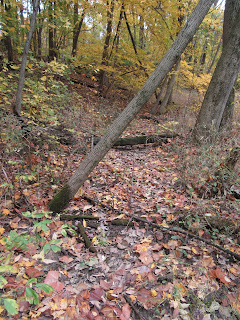Ghosts
November 21, 2017
(with photos at end from
November 25 and 29)
I am not yet ready to
declare “the death of Cottonwood Pond.” Its existence has not
been truly tested – not until we have more seasons of snow melt and
heavy downpours. Not until the “pond” becomes so filled that its
bottom surface is almost level with the surrounding land. Not until I
no longer see aquatic snails, water beetles, tadpoles, frogs.
And if it's not “dead”
yet, it can't have a “ghost.”
The photos I took on my
November 21st visit sometimes exhibited amorphous, misty
whitish areas floating within the scene.
They could have been
caused by “lens flares,” from the intense sunlight of that day
hitting the camera lens (and me not knowing how to compensate for
that,) or it could have been caused by a smudge on my lens that
collected and intensified light.
Whatever the case, they
looked interesting and I found them symbolic of what had been
happening – spirits hovering as omens of the death of Cottonwood
Pond, or spirits of positive changes and ever-flowing Life. I prefer
the latter.
The bed of fallen leaves
in the woodland and at Cottonwood Pond had become thicker, and had
lost individual, varietal color, turning yellow-brown, overall. It
was more like walking through a giant bowl of corn flake cereal, each
flake identical in color and somewhat similar in shape, deep and
crunchy (without the milk or sugar.)
An exception: the late-changing Boxelder
Leaves had clogged up any
places where water still flowed or gathered.
Creek water
Creek
The Inlet to the main pond
The main “pond” was
only a thin crescent of leafy water (like soggy corn flakes.)
Silas drinking from Cottonwood Pond
A "ghost" at "little pond"
A little bit of water visible in "little pond"
Features around the pond
that had once seemed stable and solid were on their way to becoming
ghosts of themselves.
The Inlet and the rotting Barkless Log
The mycelium of this mushroom, inside the Barkless Log, are helping to break down the wood fibers
The same is true for this purple jelly fungus on the Barkless Log
The Barkless Log begins on the opposite side of the Creek, then spans the Creek and Inlet, skirting the Root Ball. At the Root Ball it divides into and upper and lower limb. This is the lower, rapidly decaying.
The Trunk of the fallen Cottowood tree has been losing bark and supporting other forms of life (besides temporarily supporting Silas, here)
Moss and lichen on the Trunk
The Very Rotten Log, disappearing into the leaves and the ground. It extends from the other side of the Creek (distant) to the Inlet (foreground - not visible) and has lost a section to the pond itself.
The roots of the Cottonwood Root Ball have been gradually exposed, over the years, to the elements and to animal action. Pieces of them have been breaking off and falling.
The work of animals on the roots of the Root Ball Top (this and following photo)
Plants that had flourished
from spring through early autumn, full of turgid strength in their
stems, succulent leaves and colorful flowers attracting insects, had
become composed of brittle, shrunken leaves and the fluffs and husks
of late autumn seeds.
A small-leaved Aster
Another type of Aster
White Snakeroot, in the wind
Great Blue Lobelia
An old Wood Nettle plant, gradually being enveloped by the increasing Mud Pile
The flow path from the Swampy Spot (foreground) to the Inlet, through a sea of dead plant stalks
But, the “spirits” of
positive changes, of the constant Cycle of Life, were present and at
work. Already, young green plants were popping up through the deep,
dry leaf layer, promising new Life for next spring and summer. The
leaves will protect them from winter cold, snow and ice.
Honewort
Elderberry
Seedlings sprouting on the Root Ball Top
Life goes on at Cottonwood
Pond, no matter what happens.
The "Goblin's" changing face
Top edge of the Root Ball, shrinking as chunks of soil fall off
The "Ghost" of Cottonwood Pond!
************************************************************************
Later November:
November 25
November 29
November 25
November 29
























































































